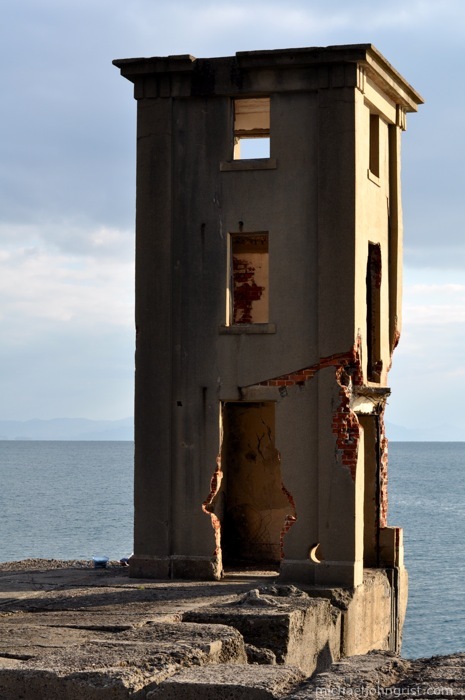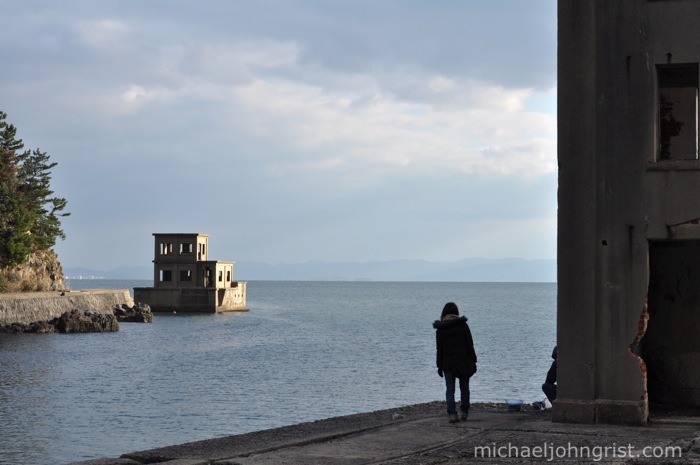Towards the end of World War 2 the Japanese military created and employed the `kaiten`, a manned suicide torpedo designed to blow up American ships with great accuracy. At that point in the War Japan had suffered severe losses, was experiencing rapid decline in its industrial capacity compared to the US, and American troops were closing in on the home islands. Surrender was out of the question, so Kaiten (along with kamikaze planes) were brought in to help tilt the balance.

Kaiten facility observation point.
`Kaiten` means `sky change` or `change of the heavens`, and it was hoped the little two-seater midget submarines would dramatically turn the tide of the war. It was thought that manned guidance would ensure every kaiten was a hit, and since they were cheaply made and the pilots who steered them barely trained, it was hoped they would cause disproportionate amounts of damage.
Early designs incorporated an escape hatch that would allow pilots to bail out when the torpedo`s course was almost complete. That hatch was removed in later versions though, leaving only the greater glory of the Emperor, great personal honor, and a post-mortem promotion of two ranks, as reward for making the ultimate sacrifice.
The project was almost an abject failure. The kaiten were made too cheap to function well, and only a few American ships were confirmed sunk by them. Many missed, detonated early, detonated late, or simply failed to explode. Its hard to imagine the frustration and shame felt by the pilots who missed, and whose auto-detonation devices failed to work. Since the kaitens were essentially single-use torpedos, they had no method of propulsion or steering. Those that missed and failed to detonate would simply sink to the ocean floor like lead weights, probably cracking open due to poor construction before they reached any considerable depth, drowning the pilots inside.

Kaiten schematics.
Kaiten, along with kamikaze plane pilots, could be considered outgrowths of the infamous Japanese `banzai charge`, a notion deeply inbred into Japanese military and samurai culture. Surrender was simply not an option. When faced by a superior enemy, the answer was not to give in but to fight until every last man, woman and child was dead. It`s a somewhat alien concept, but one that is hard not to respect. They really thought they were the Empire of the Sun. They really thought foreigners were evil devils. They really believed their Emperor was a God. They were prepared to die to protect his Empire, and did so in vast numbers. There are arguments that the nuclear bombs on Nagasaki and Hiroshima were a necessary evil to force the Japanese Emperor into surrender, as had he not, the war could have continued on and on in guerrilla action until many more were dead.
Well, those are arguments proposed by others, and I don`t necessarily support them- I`m not an expert on the subject. What I want to talk about is my brief foray into that world, to a ruined kaiten suicide boat facility on the coast of Kyushu.
SY and I went as the second haikyo on our recent Kyushu haikyo trip- the first being Kyu Nagasaki Prison. The Kaiten base was a long cold walk from the train station, but well worth it. Three main structures remained, haunted by an old fisherman at the edge of the gun-turret pier, catching fish after fish and dumping them into his plastic bucket.
We started off with the factory, a large two room stone hall where they built the torpedoes. There was nothing left to indicate that anymore, certainly no schematics, no metal equipment, tools, only the stone walls and mechanic`s pits cut into the floor. It wasn`t very big, scarcely as large as you`d expect a facility making mini-submarines to be. It was open to the sky, quiet, and peaceful.


Looking through to the gun turret.

In the foreground are shallow pits, presumably to allow mechanics to get under the kaiten.


Second we walked up to the observation tower, once accessible by a metal bridge. Now the bridge is long gone leaving an expanse of cold grey water between us and the ghosts of the islanded structure. From there soldiers would man binoculars, searching the horizon for any sign of the incoming American fleet.


A pair of sneakers sat ominously beside this big hole.

Last was the gun-turret, the last line of defence against invasion. SY chatted to the old guy fishing, who tried his best to explain to her what each building was for. `Gyorai`, he said many times. Only later did we learn that meant `torpedo`. There`s the torpedo factory, here`s the gun-turret, there`s the observation tower.


Gun turret with observation tower in back.

Through a gun turret window.



SY chats to the old fellow with his bucket of fish.

All three almost in fish-eye; factory, gun turret, observation post.


It got dusky as we left.
It was cold, and I found myself waiting for a shiver of recognition, that sense that you`re connecting to something. Perhaps I felt it, I`m not sure. The place is now weathered and barren, projecting more the level of impersonal ruin you see at an ancient druidic stone circle than anything recognizable as a station of modern war. I wondered about how the men who had served here, who had trained here, who had boarded boats and submarines as kaiten pilots, would feel about me walking around now. Taking photos of a facility symbolic of their country`s last grasp for victory.
Would they look forwards these 66 years and think- “I`m glad that`s all done with.” Or would they feel an inchoate rage that we were there at all? I wondered on this as SY chatted to the old fellow, who had a lot of fish in his bucket and was constantly adding more. He was old enough to have been alive when this place was operational, old enough to have known the Emperor as a God. I mused on this for a while.
It got coldr as the sun sank behind the clouds, and we decided to leave. We smiled at the old fellow and thanked him for the information. As we began to walk away he got up and offered us one of his fish.
We were touched. It was still flopping in his hands. We declined, because how would we cook a fish when we were staying at a hotel? He smiled as he seemed to realize this, nodded, then went back to his fishing.
See the rest of the haikyo I`ve been to in the galleries:
[album id=4 template=compact]